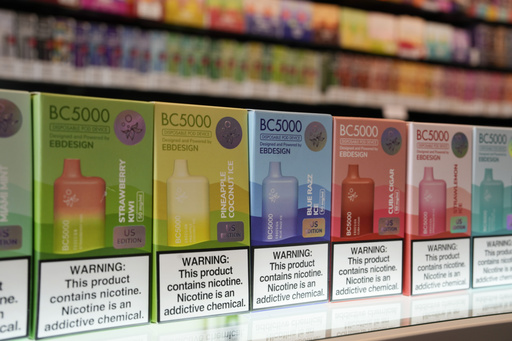Cliff Douglas fought the tobacco industry for decades. As a lawyer, activist, and executive at nonprofit organizations, he sued cigarette makers, cultivated whistleblowers, and led the campaign to ban smoking on airlines.
Which is why allies in the anti-smoking movement were surprised when in October he became CEO of the Foundation for a Smoke-Free World, a nonprofit created and entirely funded by Philip Morris International, one of the world’s largest tobacco companies.
Douglas, who previously worked for the American Cancer Society and the American Lung Association, sees his new job as the continuation of his anti-smoking work. He joined the foundation only after its board agreed to make a clean break from Philip Morris. He wants to bring together foundations, nonprofits, public health experts, elected officials, regulators, and academics in a renewed effort to curb death and disease caused by smoking.
It won’t be easy. Because anti-smoking groups aren’t just fighting the tobacco companies these days. They’re fighting, sometimes bitterly, among themselves.
“I’m under no illusions about the challenges,” Douglas says.
The stakes are high. Smoking remains the leading cause of preventable death in the United States, killing about 480,000 people a year, according to the Centers for Disease Control and Prevention. To succeed, Douglas will have to work through what he calls the “very fraught, polarized environment” that hampers the nonprofits, foundations, governments, and academics who work on tobacco control. They have fractured over tobacco harm reduction — the idea that people who cannot or will not quit smoking should be provided with alternatives, notably e-cigarettes, which deliver nicotine without burning tobacco.
Bloomberg Philanthropies and the nonprofits it supports — the Campaign for Tobacco-Free Kids and long-established groups like the American Cancer Society, the American Lung Association, and the American Heart Association — have campaigned relentlessly to limit access to e-cigarettes. The Campaign for Tobacco-Free Kids has focused on what it continues to describe as a “youth e-cigarette epidemic,” even though vaping by teens has fallen by more than 60% since its peak in 2019. They argue that e-cigarettes will lead to a new generation addicted to nicotine, even if they are not smoking.
Backed by $300 million in Bloomberg philanthropic money, along with political donations from Michael Bloomberg, the anti-vaping groups have helped convince five states – California, Massachusetts, New Jersey, New York, and Rhode Island – to ban the sale of flavored e-cigarettes. The nonprofit Truth Initiative goes further, saying it is “committed to making tobacco use and nicotine addiction a thing of the past,” which would require removing all e-cigarettes from the market. Some cities, including San Francisco, have already done so.
Douglas and his allies in the harm reduction camp say that’s been nothing short of disastrous. Bans on flavored e-cigarettes, which now cover nearly 40% of the United States, have been associated with increased sales of conventional cigarettes, according to several academic studies and financial analysts.
“These bans disincentivize the far safer product and move people back to a product that’s going to kill one in two of them,” Douglas says.
The argument threatens to derail progress on one of the most successful public health campaigns in history. The percentage of Americans who smoke has dropped from 42% in 1964 — when the first Surgeon General’s report warned of the dangers of smoking — to less than 12%. But the arrival of e-cigarettes fractured opponents of smoking, especially after startup company JUUL marketed its vapes with high nicotine levels to young people, infuriating activists and regulators.
“I can’t think of any other field of public health that has been so divided,” says Charles Gardner, a former program officer at the Foundation for a Smoke Free World and a global-health expert who previously worked at the Rockefeller and UBS Optimus foundations.
Tobacco money
The mission of the Foundation for a Smoke Free World, which Philip Morris started in 2017, is to reduce deaths and diseases caused by smoking. It focuses largely, but not entirely, on reduced-risk nicotine products, a category that includes e-cigarettes, oral tobacco, and “heat not burn” products that warm up tobacco without burning it.
This aligns with the goals of the company, which says that its future depends on replacing cigarettes with the smoke-free products that it sells. Philip Morris International promised that the foundation would be independent and said it would fund it with $80 million a year for 12 years.
Anti-smoking groups called the foundation a public relations stunt, noting that the tobacco industry has a long history of creating front groups to push its agenda. Joanna Cohen, a professor of disease prevention at the Bloomberg School of Public Health at Johns Hopkins University, and Ellen MacKenzie, the school’s dean, urged universities and nonprofits around the world to shun the foundation.
Douglas says the company has no influence over the foundation. All ties with Philip Morris were severed after accepting $122.5 million, which he characterized as a severance payment.
But some anti-tobacco advocates remain skeptical. Yolonda Richardson, president of the Campaign for Tobacco Free Kids, and Deborah Arnott, chief executive of a British health charity called Action on Smoking and Health, told Reuters that the foundation was tainted by accepting tobacco money and could not be seen as independent.
Douglas would like his critics to reserve judgment. “I’m asking those who feel doubt at this early stage to not merely rely on what I say but to watch what we do,” he says.
Vaping vs. Smoking
What, then, will the foundation do?
Douglas intends to correct widespread and dangerous misunderstandings about the relative risks of conventional cigarettes, e-cigarettes, and nicotine. There are no safe tobacco products; all fall along what’s called a continuum of risk. Nicotine pouches and gums are widely accepted because, unlike e-cigarettes, they have been approved as smoking-cessation medicines by the FDA.
That said, the vast majority of scientific experts and government agencies, including the Centers for Disease Control, say that vaping is safer than smoking, although its long-term effects remain unknown.
Public-opinion surveys, however, show that Americans mistakenly believe that e-cigarettes are as harmful or more harmful than conventional cigarettes. Misinformed smokers, therefore, have no reason to switch to the safer product.
Surprisingly, physicians are also misinformed. Surveys of doctors in the United States and around the world have found that most blame nicotine for many of the negative health consequences of smoking. Nicotine is addictive, but other chemicals and carcinogens, particularly those produced by combustion, are the primary causes of tobacco-related disease and death.
“Doctors understand that you shouldn’t be smoking,” says Michael Cummings, a tobacco-control expert at the Medical University of South Carolina. “Unfortunately, they’ve been sold a bill of goods on vaping.”
Misperceptions affect not only patients and the advice they get from doctors but also the beliefs and actions of elected officials who favor an abstinence-only approach to nicotine.
“Misunderstanding leads to poor policy,” Douglas says. While concerns about the long-term effects of vaping are valid, studies show that people who switch from conventional cigarettes to smoke-free nicotine products show immediate decreases in biomarkers associated with disease in their blood and urine.
More than anything else, Douglas would like to find common ground with the Bloomberg-funded groups around policies that would keep tobacco and nicotine products away from kids while helping adults kick their smoking habit.
______
Marc Gunther is a contributor at the Chronicle of Philanthropy, where you can read the full article. His report was provided to The Associated Press by the Chronicle of Philanthropy as part of a partnership to cover philanthropy and nonprofits supported by the Lilly Endowment. The AP and the Chronicle are solely responsible for all content. For all of AP’s philanthropy coverage, visit https://apnews.com/hub/philanthropy.
Source: post




